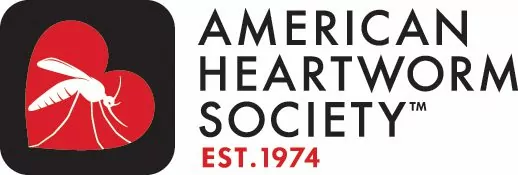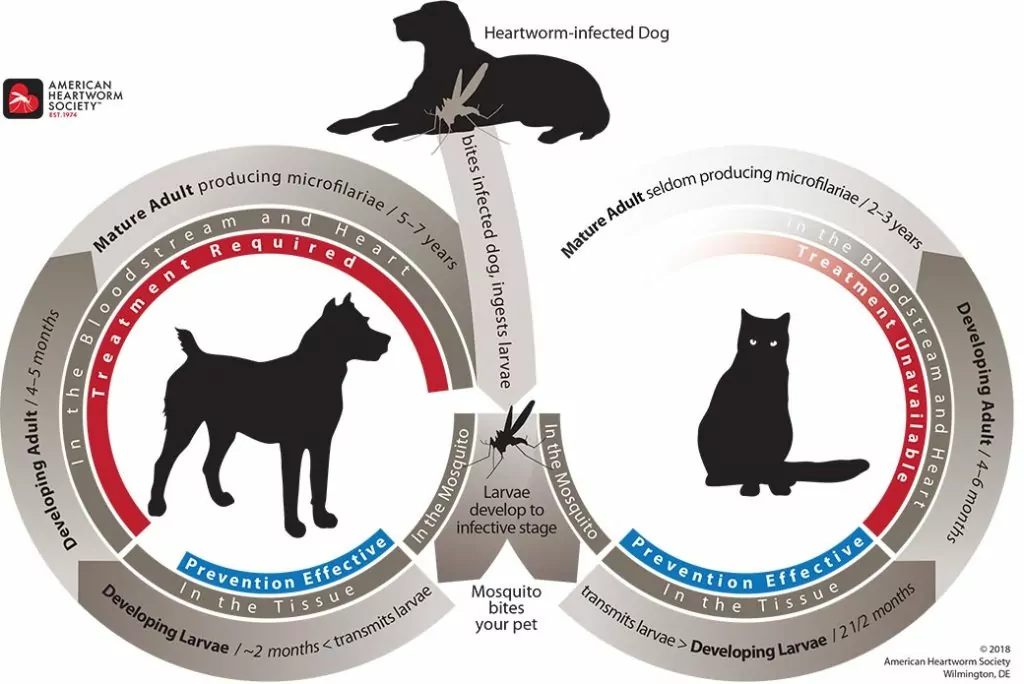So, what is there to know about the Heartworm Life Cycle? The American Heartworm Society (established in 1974) celebrates the month of April as the month to raise awareness for one devastating but preventable disease that affects our pets – the heartworm disease. We are talking about a very serious and potentially fatal condition that is caused by a parasitic worm, a roundworm, that is very long and called Dirofilaria immitis.

These worms grow very big and live in the heart, lungs and the associated blood vessels causing severe heart and lung diseases, heart failure, and damage to adjacent organs. Heartworm disease affects also wild animals such as coyotes, foxes, and ferrets that live in close proximity to domestic animals.
The heartworm life cycle is an important part of understanding how these parasites cause disease. Dogs contract heartworms when they are bitten by infected mosquitoes, not when they are given their annual round of preventative medicine.
The Heartworm Life Cycle

The Mosquito
Here’s what happens: the mosquito bites your dog and sucks up some blood-containing heartworm larvae. The mosquitoes can transmit these parasites to up to three other dogs before it lays eggs, also known as “spreading” the infection.
The Microfilaria
It takes between 10 to 14 days for the microfilaria to mature and reach the adult infective stage. The mosquito eggs are laid on the ground near your dog’s feet. They hatch into tiny worm-like larvae called microfilariae, which are small enough to float in the air.
The microfilariae then enter the bloodstream of your dog by hitching a ride through your dog’s nose or mouth on a speck of soil. Unfortunately, some of these microfilariae will be coughed up and swallowed along with your dog’s saliva.
The Bite
Then the infected mosquito bites another dog or cat and the larvae enter through the bite wound.
The Heart
The adult form is called Dirofilaria immitis. When mature, it lives in the heart. In dogs, it can survive up to seven years.
The worms reside in the pulmonary arterial system and migrate to the heart and the great veins.
Cycle Repeats
The cycle repeats every time a mosquito bites another animal.
How Can The Heartworm Life Cycle be Prevented?
You can use different approaches when it comes to heartworm prevention. There are topical “spot on” medications, chewable pills, injectable medication (given every six months). All of these are only available by prescription from your veterinarian.

The various options for prevention can only protect your dog from heartworms and others protect your pet from internal parasites and heartworm or many different parasites like fleas, mites, and ticks.
Most veterinarians are aware of the heartworm situation in their area and they are the ones who should suggest you the best prevention solution and which products to use.
Read more about our post on Heartworm Prevention Month.
The best way to stay on top of your dog’s heartworm prevention is by getting a regular heartworm test, as recommended by your veterinarian. It’s also vital to use a preventative that works fast and provides long-lasting protection from those nasty heartworms.
That’s why we recommend using Nexgard®—the first non-prescription chewable tablet that kills fleas and prevents flea infestations by treating your pet for up to 12 weeks at a time.
Facts on Heartworm Disease
- Heartworms are flat, threadlike worms that live in the heart and major arteries of both humans and animals (primarily dogs and cats). Heartworms cause many different health problems and kill their human and animal hosts.
- Heartworm disease is a particular concern in dogs and cats, and prevention of heartworm disease (prophylaxis) is the primary goal of the American Heartworm Society (AHS).
- Heartworms are transmitted when mosquitoes bite an infected dog or cat. The heartworm larvae are passed out in the feces of infected animals, which are then eaten by mosquitoes.
- After entering the animal’s body, the heartworm larvae migrate to the right side of the heart and establish themselves in blood vessels. There they grow and move to other organs, including the lungs and liver, as well as through major arteries and tissues. There may be millions of infective larvae in a single infected dog or cat.
